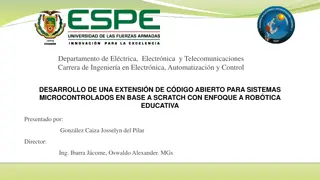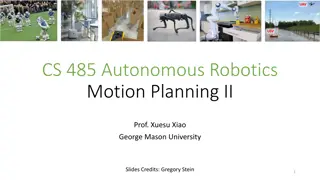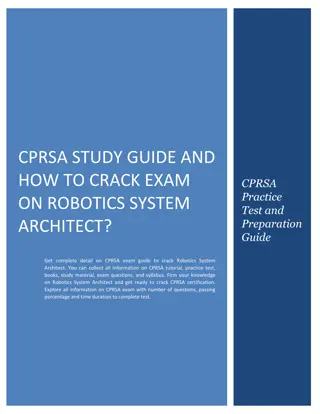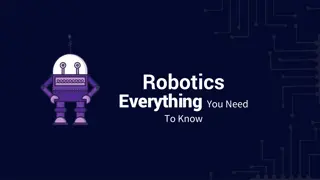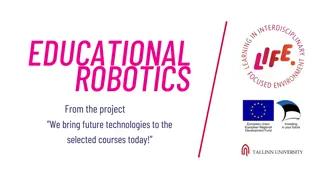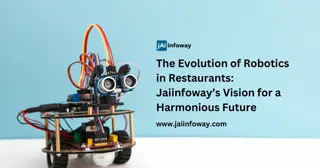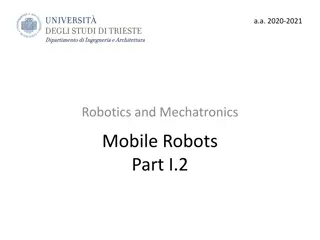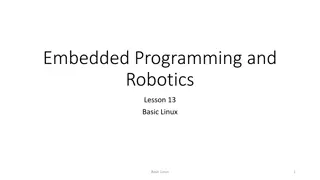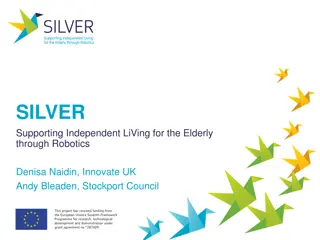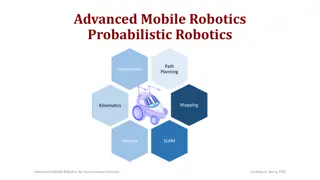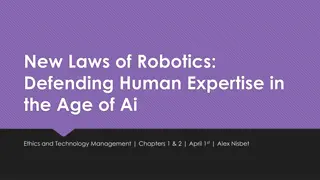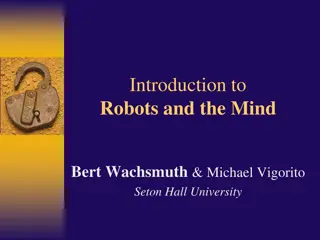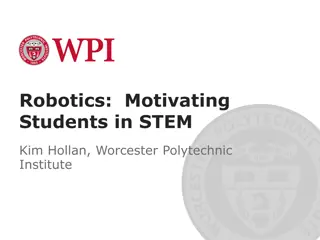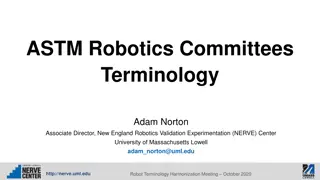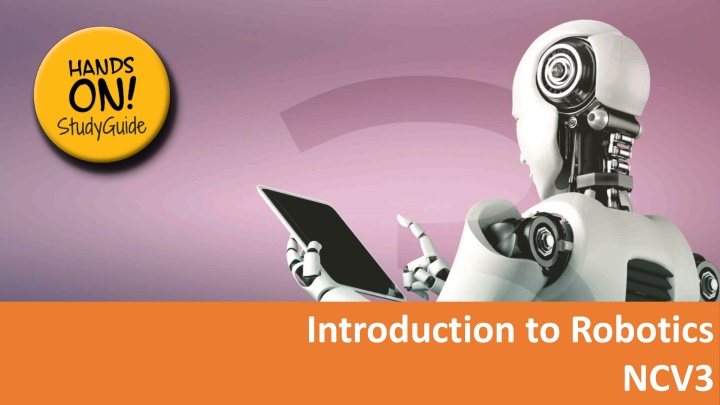
Exploring Robotics and 3D Printing in Modern Technology
Delve into the interdisciplinary field of robotics, covering topics such as mechatronics, embedded systems, and mobile robotics. Discover the world of 3D printing and additive manufacturing, turning digital designs into physical objects. Learn about the Internet of Things (IoT) and its impact on connected devices. Unleash your curiosity in the realm of intelligent systems and technological innovation.
Download Presentation

Please find below an Image/Link to download the presentation.
The content on the website is provided AS IS for your information and personal use only. It may not be sold, licensed, or shared on other websites without obtaining consent from the author. If you encounter any issues during the download, it is possible that the publisher has removed the file from their server.
You are allowed to download the files provided on this website for personal or commercial use, subject to the condition that they are used lawfully. All files are the property of their respective owners.
The content on the website is provided AS IS for your information and personal use only. It may not be sold, licensed, or shared on other websites without obtaining consent from the author.
E N D
Presentation Transcript
Module 1: Robots and our lives INTRODUCTION Robotics is a mixed discipline that combines elements of mechanical engineering, electronics, and computer science to design and build intelligent systems. www.futuremanagers.com
Module 1: Robots and our lives (continued) ROBOTICS AS A MIXED DISCIPLINE The fundamentals of robotics is that it s a mixed discipline, covering topics such as mechatronics, embedded systems, signal processing, and autonomy. Robotics is referred to as an interdisciplinary field because it involves the integration of different scientific and engineering disciplines to design, develop, and operate robots. www.futuremanagers.com
Module 1: Robots and our lives (continued) MOBILE ROBOTICS Mobile robotics is a subfield of robotics that focuses on the development of robots that are capable of moving around in their environment. This includes robots that move on wheels, legs, or even fly. Mobile robots can be used in a wide range of applications, from exploring remote locations to assisting with tasks in industrial or healthcare settings. www.futuremanagers.com
Module 1: Robots and our lives (continued) ROBOTICS AND THE INTERNET OF THINGS The Internet of Things (IoT) has been around since 1999, but in recent years has grown tremendously. Originally thought of as a way to help upload and track data without needing human input, the IoT has become a key element of smart spaces and connected devices. IoT is a network of physical devices equipped with sensors that collect and exchange data over the internet. www.futuremanagers.com
Module 2: 3D printing INTRODUCTION 3D printing provides a way to turn digital designs quickly and accurately into physical objects, in a wide range of materials and sizes. However, it is not without its own set of difficulties and drawbacks that need to be overcome. You need to understand the practicality of producing your own 3D printed parts and artefacts. www.futuremanagers.com
Module 2: 3D printing (continued) 3D PRINTING 3D printing, also known as additive manufacturing, is a process of creating physical objects, also known as artefacts. The basic concept behind 3D printing is to build up material one layer at a time to slowly create a physical artefact from a digital model. The process of 3D printing an artefact typically begins with the creation of a digital 3D model using CAD (computer assisted design) software. www.futuremanagers.com
Module 2: 3D printing (continued) THE 3D PRINTING PROCESS AND CHALLENGES As new methods and materials are developed it is easy to start seeing 3D printing as a one-stop-shop for making anything you can imagine, but that is not yet the case. Some challenges are that 3D printing is expensive, and the materials are weak compared to wood, glass, metals and other plastics. www.futuremanagers.com
Module 2: 3D printing (continued) PRINT A 3D OBJECT/ARTEFACT 3D printing is a deeply complex skill, with many variables that need to be accounted for to produce a satisfactory print. There are so many settings to adjust, pitfalls to avoid, and ways to optimise prints that a newcomer won t even be aware of. It takes a long time before you will be able to just print something and the only way to get there is through practice. Prints will fail, printers will break down or malfunction, and it is important to view these moments as opportunities to learn and improve. www.futuremanagers.com
Module 3: Electronics for robotics INTRODUCTION Robots are made up of electronic components, and a basic understanding of electricity is essential to understanding how electronics works. www.futuremanagers.com
Module 3: Electronics for robotics (continued) ELECTRICAL POWER Electrical power refers to the rate at which electrical energy is transferred or consumed in an electrical circuit or device. Power takes into account both the amount of potential energy (voltage) of the electrons, as well as the number of electrons that flow through the circuit. The unit of measurement used to represent electrical power is Watts (W). Electrical power can be calculated by multiplying the voltage (V) applied to a circuit by the current (I) flowing through it. www.futuremanagers.com
Module 4: Components of a robot INTRODUCTION In order to build an effective and efficient robot, it is important to have a comprehensive mental catalogue of the different components one can use. You can t make a cake without choosing the right ingredients, and you cannot make a capable robot without knowing what tools you have at your disposal. Selecting the correct parts is an easily overlooked part of designing a robotic solution to a problem. www.futuremanagers.com
Module 4: Components of a robot (continued) MICROCONTROLLERS Robots are a mix of many engineering disciplines, joined together by a central brain that is programmed to make everything work together to achieve a specific goal. The most common type of brain in robotics, by a large margin, is the microcontroller. These small devices allow programmers a huge amount of flexibility and control over a system, and selecting the right microcontroller is an important step in the design of any automated system. www.futuremanagers.com
Module 4: Components of a robot (continued) ACTUATORS AND MOTOR CONTROLLERS An actuator is a mechanical or electromechanical device that is able to convert stored energy into movement. The energy can come in a variety of different forms. www.futuremanagers.com
Module 4: Components of a robot (continued) SENSORS A robot that cannot sense its environment cannot react to its environment or make intelligent choices in unpredictable situations. Sensors give devices a way to detect and measure physical phenomena, and combined with the processing power of a logic controller they can lead to some highly capable and independent machines. The accuracy and range of specialised sensors far outpace human ability, allowing reliable measurements that would be otherwise impossible. www.futuremanagers.com
Module 4: Components of a robot (continued) DISPLAYS It is important to know what an autonomous system is doing while it is operating, and displays are a great way to get visual feedback. There are many different types of information that a system can communicate, and a range of displays to match. A display component refers to a device or module that is responsible for presenting visual information or output to a user. www.futuremanagers.com
Module 4: Components of a robot (continued) WIRELESS COMMUNICATION Wireless communication provides the ability for devices to communicate with other devices and networks without having to worry about issues like wiring, space limitations and obstacles. The value of being able to set up a device, connect it to battery and have it connect to nearby devices cannot be overstated. www.futuremanagers.com
Module 5: Programming INTRODUCTION Microcontrollers are embedded devices designed to execute specific tasks, and their widespread use in various applications has revolutionised the field of electronics. Understanding the basics of microcontroller programming is essential for harnessing their power and unleashing their potential. Whether you are a beginner or have prior experience in programming, you will get to know the essential concepts, from the structure of a microcontroller program to the manipulation of registers, memory, and I/O ports. www.futuremanagers.com
Module 5: Programming (continued) BASIC CONCEPTS OF MICROCONTROLLER PROGRAMMING Microcontrollers, like all processors and controllers, are quite ineffective if they are not instructed to perform tasks. The basic concept of using a microcontroller is to program the IO pins to control either inputs or outputs (or sometimes both) in the input-process-output cycle. www.futuremanagers.com
Module 5: Programming (continued) MICROCONTROLLER PROGRAMMING AND PROGRAMMING LANGUAGE INTERFACE INSTRUCTIONS Microcontrollers combine programming with physical and electrical components, which adds even more layers on top of that. The Arduino UNO is a versatile and affordable microcontroller perfectly suited to projects and prototypes. www.futuremanagers.com
Module 5: Programming (continued) MICROCONTROLLER PROGRAMMING, PRACTICAL PROJECTS AND PHYSICAL COMPUTING Automated systems have to exist in the real world, where faulty parts and environmental conditions add variables that cannot be predicted. The best way to learn how to program is to explore, experiment, and learn from your mistakes. The internet is an incredible resource, and there is no shortage of freely available learning materials at your disposal. www.futuremanagers.com
Module 6: Practical robotics INTRODUCTION The best way to gain experience of building robots is not just by reading about them but rather by building, testing, debugging and programming your own robots. www.futuremanagers.com
Module 6: Practical robotics (continued) PRACTICAL ROBOTICS PROJECTS GUIDE The internet is filled with excellent how-to guides, instruction videos and project showcases, so it is important to know the best way to translate those resources into a working prototype. www.futuremanagers.com
Module 6: Practical robotics (continued) DESIGN AND DEVELOPMENT OF AN AUTOMATED ARTEFACT OR PROTOTYPE Analysis of the problem, design components, presenting decomposition of components, designing applicable circuit schematics, applicable software prototyping and design tools, composing code, developing and debugging source code, moving the applicable code to the controller, device testing, finishing the design and artefact and creating a user manual are important to understand when designing and developing an artefact. www.futuremanagers.com


